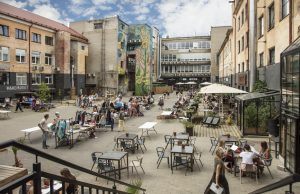Citizens and Governments as Partners for a Vibrant Democracy
This blog was originally posted on the e-Governance Academy’s website here.
“No man is an island”, as English poet John Donne famously wrote. The ties people establish within a community tell us how healthy democratic life is. Be it in a municipality, a region, or a country, the quality of these systems of relations exemplifies the presence of social capital. This represents the potential that can be unlocked in civil society, also through the extensive use of technological tools, to overcome common challenges and pursue shared goals.
Governments at all levels are not merely tasked with elaborating policies to achieve such targets. Increasingly, they can also work as facilitators, regarding citizens and organizations as partners, crucially contributing to the development of generalized trust in an open, vibrant community.
Kristina Reinsalu, Programme Director of e-Democracy here at e-Governance Academy (eGA), shows how citizens can be governments’ best friends when – enabled by ICTs – the two come together in the co-creation of public services and grass-root policies.
A tool for civic engagement – Open Government PartnershipThe Open Government Partnership (OGP) is a multi-stakeholder initiative focused on improving government transparency, ensuring opportunities for citizen participation in public matters, and strengthen... More (OGP)
In her capacity, Reinsalu has consulted many local governments in Estonia and abroad on best practices for enhancing openness and engagement. These two elements, paired with transparencyAccording to OGP’s Articles of Governance, transparency occurs when “government-held information (including on activities and decisions) is open, comprehensive, timely, freely available to the pub... More, are key to bridging the gap between people and administrators. “Power is not executed only by governments, regardless of their level, but policies and decisions are prepared engaging citizens and representatives of the civil society alike – those directly affected by the same policies and decision. This is the main idea behind open governance,” Reinsalu explains.

Kristina Reinsalu in the seminar for the municipality officials of Georgia.
Photo Credit: Helen Aasa
Striving for more openness is not a one-sided venture. As for other matters in life, two are the parties involved – governments and citizens, whose activities depend on the outcomes of the engagement process. “The executive side must be able to foster engagement. Citizens, by their part, must be willing and incentivized to participate. But for this to happen, it is necessary to create awareness and understanding over the decisions to be made, as well as their impact,” Reinsalu continues.
To this end, delivering information accurately and transparently plays a crucial role. “Openness and information allow the civil society to participate, propose solutions to shared challenges, co-create the basis for new legislationCreating and passing legislation is one of the most effective ways of ensuring open government reforms have long-lasting effects on government practices. Technical specifications: Act of creating or r.... Governments and citizens then can collaborate as partners, accountable towards each other, to achieve great things,” Reinsalu highlights.
From democratic values to participation. Social capital as an investment
An Open Government Partnership (OGP) framework is the ideal setting for policy making, as those represented and their representatives cooperate to shape the common good. The whole initiative and relevant action plans are based on the idea that democracy finds meaning also outside and beyond the ballot box. Citizens vote to define the configuration of decision-making bodies such as local councils and national parliaments. But in a healthy democratic environment, public administrators seek to mobilize resources in society to enhance inclusivity, justiceTo address barriers that prevent citizens from having their justice needs met, OGP participating governments are working to expand transparency, accountability, and inclusion into all systems of justi..., and informed participation day-by-day.

Photo: Rasmus Jurkatam
Research has shown how governments’ performance is intimately connected to civic activism. Political scientist Robert Putnam, in his seminal twenty-year study of regional public assemblies, found that successful democratic governance relies on citizens’ active participation in public affairs, cooperation, solidarity and trust. A flourishing support system of voluntary associations is also fundamental, as it allows people to access information and political ideas, increasing governments’ accountability.
These key components of social capital enable communities to establish closer relationships with their representatives, and vice versa. American sociologist Pamela Paxton, indeed, finds that there are reinforcing feedback effects between democracy and social capital. A vibrant and engaged society is fertile ground for positive democratic attitudes and generalized trust. On the other hand, though, this is possible where institutions believe in people’s contribution to the making of the common good.
“We need innovative mechanisms and nudging to create an informed, demanding, critical civil society. But the OGP framework, in this sense, could be very useful as a soft pressure mechanism. When enabled to do so, civil society can require governments to be more open, responsive, and accountable. And if public services and projects emerge from these partnerships, they are better designed, ensuring higher quality and consideration of various perspectives,” Reinsalu outlines.
Participative democracy at work, in Estonia and beyond
This virtuous approach to all levels of democratic governance has been embraced globally by an increasing number of countries. As e-Governance Academy, our commitmentOGP commitments are promises for reform co-created by governments and civil society and submitted as part of an action plan. Commitments typically include a description of the problem, concrete action... to improving the links between people and administrators incorporates technology as the enabler of better democratic practices. And the results so far have been remarkable. Not only we raised awareness, as the first proponents of the framework in Estonia, but OGP is now a successful common practice in many local municipalities.
It is not by chance that Estonia ranks among the top performers globally in terms of civic engagement within OGPs. To date, 53 projects have been carried out in the country since 2012, with 6 currently active in the realm of open data, public participation, and public service delivery – and an action plan for the next two years already under development.

Apparatus factory in Tartu was one of the projects implemented within participatory budgeting. Photo: Riina Varol
eGA has taken a leading role in making transparency and engagement pillars of local governments’ activities. The successful practice of Participatory Budgeting (PB) in Tartu is a chief example of that. Initiatives in Moldova and Georgia aimed at increasing capacity-building and citizen engagement, as well as implementing efficient information systems for municipalities, prove the effectiveness of OGP strategies.
“OGP has been impactful in many new democracies. However, in countries still struggling with systemic problems of corruption and social trust we see even bigger benefits, by recalling administrators to accountability and pressuring them into implementing healthier democratic practices. Civic and democratic attitudes depend from cultural and historical contexts, they are not something we can copy. But creating an original well-functioning, efficient state apparatus through participatory initiatives can help develop the core mechanisms of our representative democracies. In this sense, the OGP framework definitely comes at the service of both citizens and governments,” Reinsalu concludes. The lessons we learned in Estonia, Georgia, and elsewhere, are encouraging. Local OGP action plans are a viable path towards more transparent, accountable, and engaging governance.

Leave a Reply